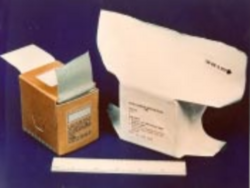Social:Chemical Agent Detector Paper
Chemical Agent Detector Paper is a type of paper used for detecting the presence of chemical agents, including nerve agents, mustard agents, and blister agents. The paper typically change color in the presence of a chemical agent. The U.S. Military and first responders typically use the paper.
M8 Detector Paper

M8 Detector Paper is used to detect the presence of V and G type nerve agents and H type blister agents. It works by detecting chemical agents from a liquid splash. Each sheet of paper has three separate detection dyes. The yellow color appears when exposed to G nerve agents, the dark green color appears when exposed to V nerve agents, and the red color appears when exposed to H blister agents.[1] The M8 detector paper does not detect agents in the form of aerosols or vapors.
The M8 was a Canadian invention, being first standardized in 1963.[2] By 1964 it entered United States service as part of the M15A2 Chemical Agent Detector Kit, with about 67,000 of these kits being produced from 1965-1969, with most other NATO nations also purchasing the M8.[2]
M9 Detector Tape

M9 Detector Tape or paper is used to detect the presence of nerve (V- and G- types) and mustard (H, HD, HN, and HT) agents.[3] It cannot identify what particular agent it is being exposed to. The tape is typically a dull cream color when not exposed to chemical agents, but will turn red in the presence of chemical agents.[4] The tape is made from Mylar, which is the sticky backing, and a red agent detection dye. The detector tape does have false positives, which can be caused by antifreeze, petroleum-based products, and liquid insecticide.
The M9 was adopted by the US Army in 1980, although prior testing showed the dye used in the tape was mutagenic and possibly carcinogenic.[2] Adoption nonetheless proceeded and the Army was able to find a replacement dye that was not mutagenic.[2]
References
- ↑ "M8 Chemical Detection Paper | Chemical Kits". https://luxfermagtech.com/products/detection/m8-paper/.
- ↑ 2.0 2.1 2.2 2.3 Smart, Jeffery K.. "History of Chemical and Biological Detectors, Alarms, and Warning Systems". U. S. Army Soldier and Biological Chemical Command. https://www.hsdl.org/?view&did=1670.
- ↑ "M9 Chemical Detection Tape | Chemical Kits". https://luxfermagtech.com/products/detection/m9-paper/.
- ↑ "210.pdf". https://www.trngcmd.marines.mil/Portals/207/Docs/FMTBE/Student%20Materials/FMSO%20Manual/210.pdf.
 |
